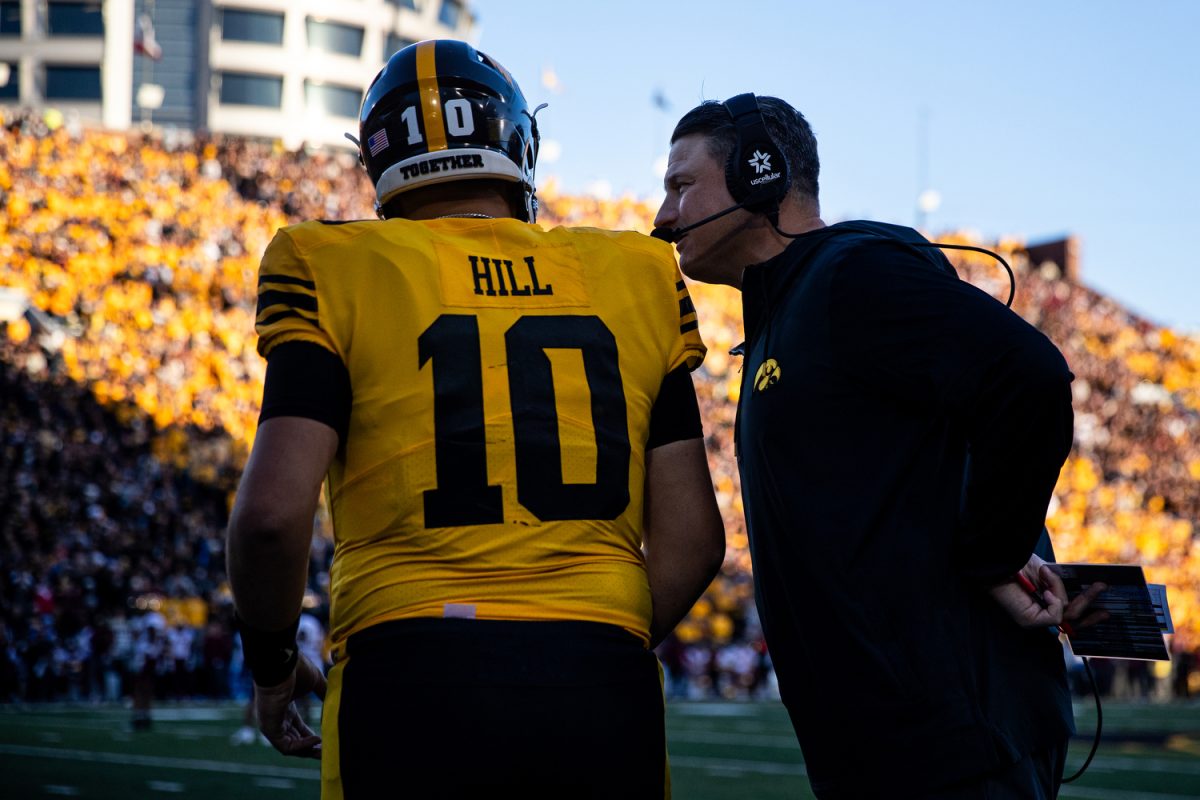Passing Offense: D-
The only reason this mark wasn’t a failure was because Deacon Hill surpassed the 100-yard mark in passing with 116 through the air, more than triple his performance last week. In fact, in the first half, Hill impressed with his ability to sneak the ball up the middle, but also his mobility in the pocket, as highlighted by his 36-yard completion to Diante Vines in the first quarter. Posting 96 passing yards at halftime, it appeared the Wisconsin transfer might finally have his first showcase game in the Black and Gold. This proved to be a pipe dream, however, as Hill completed just three passes for 15 yards and an interception in the final minute of play. His two fumbles also didn’t do any favors. One of the biggest guys on the field shouldn’t be dropping the ball when hit. Hill took ownership of his mistakes, which I greatly respect, but will have plenty to work on over the bye week, as Kirk Ferentz said after the game he is still the starter.
Rushing Offense: F-
The only statistic that I should have to say here is 0.4 rushing yards per attempt. That should tell you all you need to know about how awful the Iowa ground game was on Saturday. Known for making a big play once a game, Hawkeye running backs failed to produce a play longer than 10 yards in this contest. It’s not as if Minnesota had a stout defense against the run either, ranking 64th in the FBS heading into Saturday. Sure, the Gophers stacked the box with safeties, knowing the predictability of the Hawkeye offense, but that’s not an excuse for this measly outcome.
Passing Defense A-
Holding Gopher quarterback Athan Kaliakmanis to just eight yards in the air at the end of the first half was a great indicator of the prowess of the Hawkeye secondary. Yet in the final thirty minutes, it appeared fatigue struck the group, as it allowed three plays of more than 15 yards, one of which set up Minnesota for its go-ahead field goal. Iowa safety Quinn Schulte said after the game that the defense didn’t execute when it needed to during the second half, and he wouldn’t be incorrect in that statement. Nevertheless, spending more than half the game on the field won’t do the unit any favors.
Rushing Defense: A
The return of star Minnesota running Darius Taylor was duly noted by the Hawkeye “D,” who held him to just 59 yards on the ground for an average of 3.7 per carry. Heading into the contest with 532 rushing yards in just four games, Taylor was neutralized in this matchup, a rather common outcome for Iowa this season against stout ball-carriers. Holding the Gophers to 113 rushing yards, the longest Dash the Hawkeyes let up was 11 yards. With the high standard placed upon the Iowa defense, it may be logical to ask for a forced fumble, that would almost be too much to ask for a unit that spends way too much time on the field as it is.
Special Teams: A
Hawkeye punter Tory Taylor was once again brilliant on Saturday, booting nine balls for an average of 49.3 yards, five of which landed inside the 20, and one of which was downed at the one-yard line. Kicker Drew Stevens was perfect on the day, and of course, returner Cooper DeJean could’ve made yet another etch in Hawkeye history with another game-winning punt return touchdown. Alas, the officials didn’t make it so, leaving the only blemish to coordinator LeVar Woods’ unit.
Coaching: B-
Iowa looked flat-out scared to test the Minnesota defense in going for it on fourth-and-one, instead electing to punt both times, even when near the 50-yard line. Granted, one of those choices did pay off, as the Hawkeyes received better field position following a Gopher three-and-out, driving the ball 46 yards for a touchdown. And in spite of getting the wide receiver way more involved than in the past month, the Hawkeye offensive scheme lacked explosiveness and momentum in one-dimensional playcalling that relied on the run and screen passes over the middle.



